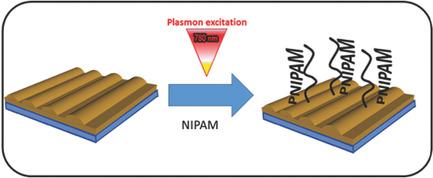当前位置:
X-MOL 学术
›
Adv. Mater. Interfaces
›
论文详情
Our official English website, www.x-mol.net, welcomes your feedback! (Note: you will need to create a separate account there.)
Plasmon‐Polariton Induced, “from Surface” RAFT Polymerization, as a Way toward Creation of Grafted Polymer Films with Thickness Precisely Controlled by Self‐Limiting Mechanism
Advanced Materials Interfaces ( IF 5.4 ) Pub Date : 2018-10-04 , DOI: 10.1002/admi.201801042 Mariia Erzina 1, 2 , Olga Guselnikova 1, 2 , Pavel Postnikov 1, 2 , Roman Elashnikov 1 , Zdenka Kolska 3 , Elena Miliutina 3 , Václav Švorčík 1 , Oleksiy Lyutakov 1, 2
Advanced Materials Interfaces ( IF 5.4 ) Pub Date : 2018-10-04 , DOI: 10.1002/admi.201801042 Mariia Erzina 1, 2 , Olga Guselnikova 1, 2 , Pavel Postnikov 1, 2 , Roman Elashnikov 1 , Zdenka Kolska 3 , Elena Miliutina 3 , Václav Švorčík 1 , Oleksiy Lyutakov 1, 2
Affiliation

|
Plasmon‐induced “from surface” reversible addition‐fragmentation chain‐transfer (RAFT) polymerization is reported for the first time. The gold grating surface, supporting the surface plasmon polariton excitation and propagation, is grafted with RAFT agent, immersed in the solution, containing the NIPAm monomer and AIBN and subsequently illuminated at a wavelength corresponding to plasmon absorption. The grafting of the polymer layer, its thickness, and morphology are characterized by several techniques (including the surface‐enhanced Raman spectroscopy (SERS), scanning electron microscopy and energy‐dispersive X‐ray spectroscopy (SEM‐EDX), X‐ray photoelectron spectroscopy (XPS), nanomechanical atomic force microscopy (AFM) mapping, and goniometry). It is shown that the polymerization efficiently starts only under the surface plasmon‐polariton excitation. The time‐dependent SERS and XPS measurements indicate rather self‐limiting nature of plasmon‐induced “from the surface” PNIPAm growth, namely the reaction takes place up to a certain polymer thickness and is stopped despite a significant excess of polymerization initiator and monomer in the reaction solution. The present results provide the basis for designing further experiments on plasmonic catalysis in general and offer a new way of producing ultrathin polymer films with a defined structural dimension.
中文翻译:

等离子-极化由“表面” RAFT聚合引发,是一种通过自限机制精确控制厚度的接枝聚合物膜的制备方法
首次报道了等离子诱导的“从表面”可逆加成-断裂链转移(RAFT)聚合。将支持表面等离激元极化激发和传播的金光栅表面接枝有RAFT剂,浸入含有NIPAm单体和AIBN的溶液中,随后以对应于等离激元吸收的波长照射。聚合物层的接枝,厚度和形态通过多种技术进行表征(包括表面增强拉曼光谱(SERS),扫描电子显微镜和能量色散X射线光谱法(SEM-EDX),X射线光电子光谱(XPS),纳米机械原子力显微镜(AFM)测绘和测角法)。结果表明,聚合仅在表面等离振子-极化子激发下才有效地开始。随时间变化的SERS和XPS测量结果表明,等离激元诱导的“从表面” PNIPAm生长具有相当的自限性,即反应发生到一定的聚合物厚度,尽管聚合引发剂和单体中明显过量,反应仍会停止。反应溶液。目前的结果为一般设计等离子体激元催化实验提供了基础,并提供了一种生产具有确定结构尺寸的超薄聚合物薄膜的新方法。也就是说,尽管反应溶液中聚合引发剂和单体明显过量,反应仍会发生,直至达到一定的聚合物厚度,并终止反应。目前的结果为一般设计等离子体激元催化实验提供了基础,并提供了一种生产具有确定结构尺寸的超薄聚合物薄膜的新方法。也就是说,尽管反应溶液中聚合引发剂和单体明显过量,反应仍会发生,直至达到一定的聚合物厚度,并终止反应。目前的结果为一般设计等离子体激元催化实验提供了基础,并提供了一种生产具有确定结构尺寸的超薄聚合物薄膜的新方法。
更新日期:2018-10-04
中文翻译:

等离子-极化由“表面” RAFT聚合引发,是一种通过自限机制精确控制厚度的接枝聚合物膜的制备方法
首次报道了等离子诱导的“从表面”可逆加成-断裂链转移(RAFT)聚合。将支持表面等离激元极化激发和传播的金光栅表面接枝有RAFT剂,浸入含有NIPAm单体和AIBN的溶液中,随后以对应于等离激元吸收的波长照射。聚合物层的接枝,厚度和形态通过多种技术进行表征(包括表面增强拉曼光谱(SERS),扫描电子显微镜和能量色散X射线光谱法(SEM-EDX),X射线光电子光谱(XPS),纳米机械原子力显微镜(AFM)测绘和测角法)。结果表明,聚合仅在表面等离振子-极化子激发下才有效地开始。随时间变化的SERS和XPS测量结果表明,等离激元诱导的“从表面” PNIPAm生长具有相当的自限性,即反应发生到一定的聚合物厚度,尽管聚合引发剂和单体中明显过量,反应仍会停止。反应溶液。目前的结果为一般设计等离子体激元催化实验提供了基础,并提供了一种生产具有确定结构尺寸的超薄聚合物薄膜的新方法。也就是说,尽管反应溶液中聚合引发剂和单体明显过量,反应仍会发生,直至达到一定的聚合物厚度,并终止反应。目前的结果为一般设计等离子体激元催化实验提供了基础,并提供了一种生产具有确定结构尺寸的超薄聚合物薄膜的新方法。也就是说,尽管反应溶液中聚合引发剂和单体明显过量,反应仍会发生,直至达到一定的聚合物厚度,并终止反应。目前的结果为一般设计等离子体激元催化实验提供了基础,并提供了一种生产具有确定结构尺寸的超薄聚合物薄膜的新方法。


























 京公网安备 11010802027423号
京公网安备 11010802027423号